外文翻译文献综述
文献综述及外文翻译

关于钢铁制造企业的物料控制研究参考文献综述学号408417011320,姓名党杨前言:依美国生产及库存管理学会(American Production and Inventory Control Sociery,APICS)的定义,物料(Materials)是指制造产品或提供服务时所需直接或间接投入的物料。
物料一词所涉及的范围相当广泛,除企业生产过程中所需直接投入的物料外,还涉及所需间接投入的物料。
而物料控制简称物控,是指对企业生产经营活动所需各种物料的储存、请购与采购、收发、保管与搬运等业务活动进行的计划、实施及控制。
随着全球经济一体化进程的加快,制造企业正面临市场预测不准、计划多变、物料控制难度大、物流成本居高不下等严峻问题。
如何建立高效的物料控制运作体系,提高物料控制对生产与销售计划变动的适应性和快速反应能力;如何有效控制物料消耗,控制物料库存和在制品占用;如何强化采购业务管理,提升物料跟催力敌,确保物料供应;如何根据ISO9000和TS16949国际质量认证要求,实行物料从入库接收、储存保管到出库、配送全过程规范管理等,已成为制造企业降低物流成本、提升对市场需求快速反应能力的关键。
从查找的文献来看,我们了解到目前针对物料控制的研究越来越多,解决方法也各不相同,本文从近几年我国学者研究物料控制以及成本计划的相关文献20余篇中选择了其中的10篇,来说明我国物料管理的一些现实问题和发展方向。
在研读文献之后,笔者可以获知目前国内学者对物料控制的研究主要有以下三个方向:1.面向订单的物料控制;2.面向供应链的物料控制;3.面向物料清单管理的物料控制。
正文:物料控制的研究早在18世纪70年代的英国就已经初现雏形。
傅和彦的《现代物料管理》指出,自工业革命开始后,工厂制度逐渐形成。
物料的采购、储存、存量管制、加工及呆废料的处理问题等处处影响工厂经营的绩效与盈亏,物料控制因而逐渐引起普遍的重视,18世纪70年代单边检验的应用及双边检验的出现,开创了物品品质检验的里程碑。
英语笔译文献综述

英语笔译文献综述Here is an essay on the topic of "A Literature Review on English-Chinese Translation" with over 1000 words, written in English without any additional punctuation marks in the body of the text.The field of English-Chinese translation has been a subject of extensive research and study for decades. As the world becomes increasingly interconnected, the demand for accurate and effective translation services has grown significantly. This literature review aims to provide an overview of the current state of research in this field, highlighting key themes, methodologies, and areas for further exploration.One of the primary focuses in English-Chinese translation research has been on the linguistic and cultural challenges inherent in the process. Scholars have examined the differences in grammatical structures, idioms, and cultural references between the two languages, and how these disparities can impact the quality and accuracy of translations. Studies have explored strategies for navigating these challenges, such as the use of machine translation, the role of human translators, and the importance of cultural awareness and adaptation.Another area of research has been the impact of technological advancements on the translation industry. The rise of machine translation, computer-assisted translation tools, and cloud-based platforms has transformed the way translation services are delivered. Researchers have investigated the strengths and limitations of these technologies, as well as the implications for the role of human translators in the future. Additionally, studies have examined the ethical considerations surrounding the use of artificial intelligence in translation, such as issues of data privacy, bias, and the potential displacement of human workers.The quality and evaluation of English-Chinese translations have also been the subject of extensive research. Scholars have developed frameworks and methodologies for assessing the accuracy, fluency, and overall effectiveness of translations, taking into account factors such as linguistic equivalence, cultural appropriateness, and the intended purpose of the translation. These evaluation methods have been applied to a wide range of translation contexts, including literary works, technical documents, and business communications.Another area of focus in the field of English-Chinese translation is the training and professional development of translators. Researchers have explored the skills, knowledge, and competencies required for effective translation, and have investigated the bestpractices for educating and training translators. This includes the use of translation-specific curricula, the integration of technology into the learning process, and the importance of ongoing professional development and certification.In addition to these core areas of research, scholars have also examined the role of English-Chinese translation in various domains, such as international business, education, and healthcare. These studies have explored the unique challenges and considerations that arise in these specialized contexts, and have provided insights into the strategies and approaches that can lead to successful translations.Despite the significant progress that has been made in the field of English-Chinese translation, there are still many areas that require further research and exploration. For example, the impact of globalization and the increasing use of English as a lingua franca on translation practices is an emerging area of interest. Additionally, the ethical implications of translation, such as the potential for misrepresentation or the perpetuation of cultural biases, warrant deeper examination.Furthermore, the field of English-Chinese translation would benefit from more interdisciplinary collaboration, drawing on insights from fields such as linguistics, cognitive science, and cultural studies. By fostering a more holistic and multifaceted approach to translationresearch, scholars can gain a deeper understanding of the complexities and nuances involved in the process.In conclusion, the field of English-Chinese translation has been the subject of extensive research and study, yielding valuable insights into the linguistic, cultural, and technological challenges involved in the translation process. As the demand for translation services continues to grow, it is crucial that researchers and practitioners work together to advance the field, develop innovative solutions, and ensure the highest quality of translation services. By doing so, they can contribute to greater cross-cultural understanding and effective communication in an increasingly globalized world.。
文献综述及外文文献翻译

⽂献综述及外⽂⽂献翻译华中科技⼤学⽂华学院毕业设计(论⽂)外⽂⽂献翻译(本科学⽣⽤)题⽬:Plc based control system for the music fountain 学⽣姓名:_周训⽅___学号:060108011117 学部(系): 信息学部专业年级: _06⾃动化(1)班_指导教师:张晓丹___职称或学位:助教__20 年⽉⽇外⽂⽂献翻译(译成中⽂1000字左右):【主要阅读⽂献不少于5篇,译⽂后附注⽂献信息,包括:作者、书名(或论⽂题⽬)、出版社(或刊物名称)、出版时间(或刊号)、页码。
提供所译外⽂资料附件(印刷类含封⾯、封底、⽬录、翻译部分的复印件等,⽹站类的请附⽹址及原⽂】英⽂节选原⽂:Central Processing Unit (CPU) is the brain of a PLC controller. CPU itself is usually one of the microcontrollers. Aforetime these were 8-bit microcontrollers such as 8051, and now these are 16-and 32-bit microcontrollers. Unspoken rule is that you’ll find mostly Hitachi and Fujicu microcontrollers in PLC controllers by Japanese makers, Siemens in European controllers, and Motorola microcontrollers in American ones. CPU also takes care of communication, interconnectedness among other parts of PLC controllers, program execution, memory operation, overseeing input and setting up of an output. PLC controllers have complex routines for memory checkup in order to ensure that PLC memory was not damaged (memory checkup is done for safety reasons).Generally speaking, CPU unit makes a great number of check-ups of the PLC controller itself so eventual errors would be discovered early. You can simply look at any PLC controller and see that there are several indicators in the form. of light diodes for error signalization.System memory (today mostly implemented in FLASH technology) is used by a PLC for a process control system. Aside form. this operating system it also contains a user program translated forma ladder diagram to a binary form. FLASH memory contents can be changed only in case where user program is being changed. PLC controllers were used earlier instead of PLASH memory and have had EPROM memory instead of FLASH memory which had to be erased with UV lamp and programmed on programmers. With the use of FLASH technology this process was greatly shortened. Reprogramming a program memory is done through a serial cable in a program for application development.User memory is divided into blocks having special functions. Some parts of a memory are used for storing input and output status. The real status of an input is stored either as “1”or as “0”in a specific memory bit/ each input or output has one corresponding b it in memory. Other parts of memory are used to store variable contents for variables used in used program. For example, time value, or counter value would be stored in this part of the memory.PLC controller can be reprogrammed through a computer (usual way), but also through manual programmers (consoles). This practically means that each PLC controller can programmed through a computer if you have the software needed for programming. Today’s transmission computers are ideal for reprogramming a PLC cont roller in factory itself. This is of great importance to industry. Once the system is corrected, it is also important to read the right program into a PLC again. It is also good to check from time to time whether program in a PLC has not changed. This helps to avoid hazardous situations in factory rooms (some automakers have established communication networks which regularly check programs in PLC controllers to ensure execution only of good programs). Almost every program for programming a PLC controller possesses various useful options such as: forced switching on and off of the system input/outputs (I/O lines),program follow up in real time as well as documenting a diagram. This documenting is necessary to understand and define failures and malfunctions. Programmer can add remarks, names of input or output devices, and comments that can be useful when finding errors, or with system maintenance. Adding comments and remarks enables any technician (and not just a person who developed the system) to understand a ladder diagram right away. Comments and remarks can even quote precisely part numbers if replacements would be needed. This would speed up a repair of any problems that come up due to bad parts. The old way was such that a person who developed a system had protection on the program, so nobody aside from this person could understand how it was done. Correctly documented ladder diagram allows any technician to understand thoroughly how system functions.Electrical supply is used in bringing electrical energy to central processing unit. Most PLC controllers work either at 24 VDC or 220 VAC. On some PLC controllers you’ll find electrical supply as a separate module. Those are usually bigger PLC controllers, while small and medium series already contain the supply module. User has to determine how much current to take from I/O module to ensure that electrical supply provides appropriate amount of current. Different types of modules use different amounts of electrical current. This electrical supply is usually not used to start external input or output. User has to provide separate supplies in starting PLC controller inputs because then you can ensure so called “pure” supply for the PLC controller. With pure supply we mean supply where industrial environment can not affect it damagingly. Some of the smaller PLC controllers supply their inputs with voltage from a small supply source already incorporated into a PLC.中⽂翻译:从结构上分,PLC分为固定式和组合式(模块式)两种。
外文翻译与文献综述模板格式以及要求说明
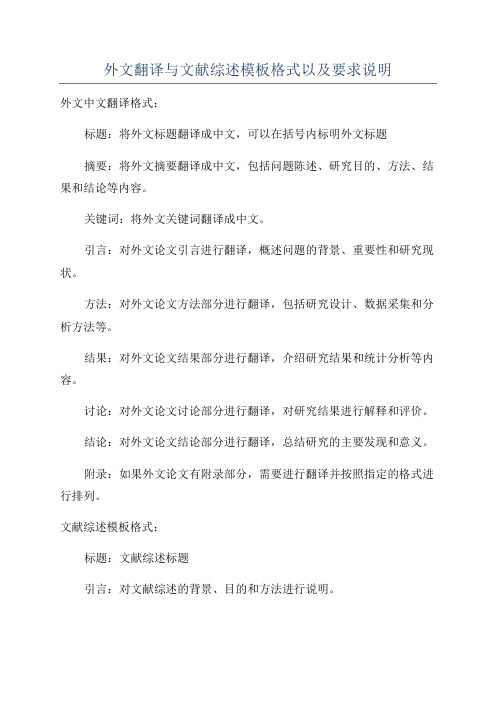
外文翻译与文献综述模板格式以及要求说明
外文中文翻译格式:
标题:将外文标题翻译成中文,可以在括号内标明外文标题
摘要:将外文摘要翻译成中文,包括问题陈述、研究目的、方法、结果和结论等内容。
关键词:将外文关键词翻译成中文。
引言:对外文论文引言进行翻译,概述问题的背景、重要性和研究现状。
方法:对外文论文方法部分进行翻译,包括研究设计、数据采集和分析方法等。
结果:对外文论文结果部分进行翻译,介绍研究结果和统计分析等内容。
讨论:对外文论文讨论部分进行翻译,对研究结果进行解释和评价。
结论:对外文论文结论部分进行翻译,总结研究的主要发现和意义。
附录:如果外文论文有附录部分,需要进行翻译并按照指定的格式进行排列。
文献综述模板格式:
标题:文献综述标题
引言:对文献综述的背景、目的和方法进行说明。
综述内容:按照时间、主题或方法等进行分类,对相关文献进行综述,可以分段进行描述。
讨论:对综述内容进行解释和评价,概括主要研究成果和趋势。
结论:总结文献综述,概括主要发现和意义。
要求说明:
1.外文中文翻译要准确无误,语句通顺流畅,做到质量高、符合学术
规范。
2.文献综述要选择与所研究领域相关的文献进行综述,覆盖面要广,
内容要全面、准确并有独立思考。
4.文献综述要注重整体结构和逻辑连贯性,内容要有层次感,段落间
要过渡自然。
5.外文中文翻译和文献综述要进行查重,确保原文与译文的一致性,
并避免抄袭和剽窃行为。
文献综述和外文翻译撰写要求与格式规范
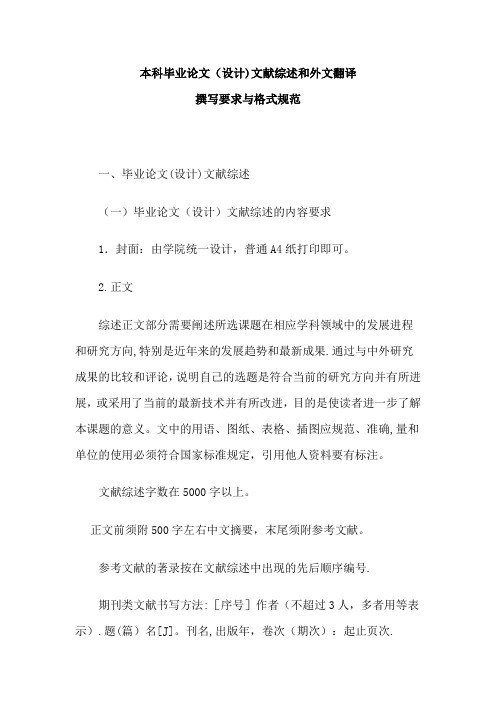
本科毕业论文(设计)文献综述和外文翻译撰写要求与格式规范一、毕业论文(设计)文献综述(一)毕业论文(设计)文献综述的内容要求1.封面:由学院统一设计,普通A4纸打印即可。
2.正文综述正文部分需要阐述所选课题在相应学科领域中的发展进程和研究方向,特别是近年来的发展趋势和最新成果.通过与中外研究成果的比较和评论,说明自己的选题是符合当前的研究方向并有所进展,或采用了当前的最新技术并有所改进,目的是使读者进一步了解本课题的意义。
文中的用语、图纸、表格、插图应规范、准确,量和单位的使用必须符合国家标准规定,引用他人资料要有标注。
文献综述字数在5000字以上。
正文前须附500字左右中文摘要,末尾须附参考文献。
参考文献的著录按在文献综述中出现的先后顺序编号.期刊类文献书写方法:[序号]作者(不超过3人,多者用等表示).题(篇)名[J]。
刊名,出版年,卷次(期次):起止页次.图书类文献书写方法:[序号]作者.书名[M].版本.出版地:出版者,出版年:起止页次。
论文集类文献书写方法:[序号]作者.篇名[C].论文集名.出版地:出版者,出版年:起止页次。
学位论文类书写方法:[序号]作者.篇名[D]。
出版地:单位名称,年份。
电子文献类书写方法:[序号]主要责任者。
题名:其他题名信息[文献类型标志/文献载体标志]出版地:出版者,出版年(更新或修改日期)[引用日期].获取和访问途径。
参考文献篇数应符合学院毕业论文(设计)工作的要求。
(二)毕业论文(设计)文献综述撰写与装订的格式规范第一部分:封面1。
封面:由学院统一设计,“本科生毕业论文(设计)"根据作业实际明确为“论文”或“设计”,其它文本、表格遇此类情况同样处理。
第二部分:文献综述主题1.中文摘要与关键词摘要标题(五号,宋体,顶格,加粗)摘要内容(五号,宋体)关键词标题(五号,宋体,顶格,加粗)关健词内容(五号,宋体,词间用分号隔开)2.正文标题标题最多分四级。
关于移动支付过去,现状,未来的文献综述外文翻译
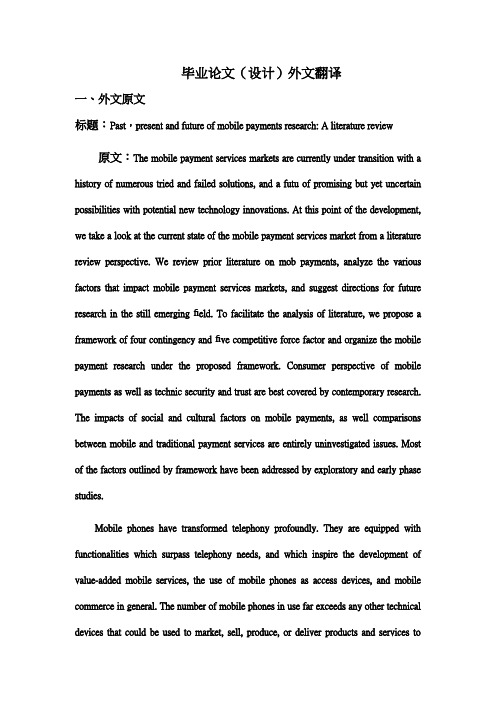
毕业论文(设计)外文翻译一、外文原文标题:Past,present and future of mobile payments research: A literature review 原文:The mobile payment services markets are currently under transition with a history of numerous tried and failed solutions, and a futu of promising but yet uncertain possibilities with potential new technology innovations. At this point of the development, we take a look at the current state of the mobile payment services market from a literature review perspective. We review prior literature on mob payments, analyze the various factors that impact mobile payment services markets, and suggest directions for future research in the still emerging field. To facilitate the analysis of literature, we propose a framework of four contingency and five competitive force factor and organize the mobile payment research under the proposed framework. Consumer perspective of mobile payments as well as technic security and trust are best covered by contemporary research. The impacts of social and cultural factors on mobile payments, as well comparisons between mobile and traditional payment services are entirely uninvestigated issues. Most of the factors outlined by framework have been addressed by exploratory and early phase studies.Mobile phones have transformed telephony profoundly. They are equipped with functionalities which surpass telephony needs, and which inspire the development of value-added mobile services, the use of mobile phones as access devices, and mobile commerce in general. The number of mobile phones in use far exceeds any other technical devices that could be used to market, sell, produce, or deliver products and services toconsumers. These developments open lucrative opportunities to merchants and service providers.Purchased products and services have to be paid for. Initially, fixed-line telephony billing systems were modified to charge mobile telephony. Later, mobile telephony billing systems were introduced, and used also to charge various mobile services when such services emerged. Yet, payments based on billing systems have several limitations. These include comparatively high payment transaction fees, merchant and service provider complaints about unfair revenue sharing, and the necessity to provision services to billing systems [66,80]. In some areas, such as the European Union, credited payment services to third parties require a (limited) credit institution license. The lack of suitable pay-ment instruments has for a long time been regarded as a factor that hampers the development of mobile commerce.Mobile payments are payments for goods, services, and bills with a mobile device (such as a mobile phone, smart-phone, or personal digital assistant (PDA)) by taking advantage of wireless and other communication technologies. Mobile devices can be used in a variety of payment scenarios, such as payment for digital content (e.g., ring tones, logos, news, music, or games), tickets, parking fees and transport fares, or to access electronic payment services to pay bills and invoices. Payments for physical goods are also possible, both at vending and ticketing machines, and at manned point-of-sale (POS) terminals.A mobile payment is carried out with a mobile payment instrument such a mobilecredit card or a mobile wallet. In addition to pure mobile payment instruments, most electronic and many physical payment instruments have been mobilized. Furthermore, mobile payments, as all other payments, fall broadly into two categories: payments for daily purchases, and payments of bills (credited payments). For purchases, mobile payments complement or compete with cash, cheques, credit cards, and debit cards. For bills, mobile payments typically provide access to account-based payment instruments such as money transfers, Internet banking payments, direct debit assignments, or electronic invoice acceptance.In the early 2000s, mobile payment services became a hot topic and remained so even after the burst of the Internet hype. Hundreds of mobile payment services, including access to electronic payments and Internet banking, were introduced all over the world. Strikingly many of these orts failed. For example, most, if not all, of the dozens of mobile payment services available in EU countries and listed in the ePSO database in 2002 [5] have been discontinued. To facilitate the development of better mobile payment services, it is important to understand the lessons of his history by learning what previous studies have discovered about mobile payments and about the mobile payment services markets, as well as what issues have remained unanswered.The aim of this paper is to summarize findings from past mobile payments research, and to suggest promising directions for future research. There are a number of factors that highlight the significance and usefulness of such a literature review. Firstly, the field has seen a growing number of publications, yet a thorough review of existing work is missing. The lack of published literature reviews impedes the progress in the field; review articlesare critical to strengthening an area as a field of study [88]. Secondly, research so far seems fragmented, and lacks a roadmap or an agenda. Reviewing existing literature not only leads to a better understanding of the state of the research in the field, but it also discerns patterns in the development of the field itself. Finally, a synthesis of existing findings allows researchers not to repeat similar work, and discover important gaps. In other words, it closes areas where a plethora of research already exists, and at the same time uncovers those areas where research is lacking [88].Another contribution of this literature review is the proposed theoretical framework, around which the review is organized. Webster and Watson [88] recommend that the best reviews need to be conceptually structured, and based on a guiding theory. Our framework provides a guiding structure that allows us to effectively accumulate knowl edge, and to interpret previous findings. Because the frame work itself aims to explain relevant factors in the mobile payment services market, basing the literature review on the framework ensures that the review is comprehensive and holistic, and reveals research gaps that could otherwise be overlooked. The framework not only helps to explain the existing body of knowledge on each factor of the frame work, but, more importantly, it also provides an overview of the mobile payment services market, illustrating how the various perspectives and research findings fit together as part of the big picture.The framework used for the review of literature applies two guiding theories. They are the five forces model developed by Porter [68], and the generic contingency theory which emerged from the work of Lawrence and Lorch Perrow and Thompson [81]. The framework is used to classify past research, to analyze research findings of classifiedstudies, and to propose meaningful research questions for future research for each factor.The prime actors in the mobile payment services market are mobile payment service providers and their customers. Various parties assuming these roles in the market include consumers, merchants, financial institutions and telecom operators. Additional parties, typically vendors of hand sets, software, networks and other technologies may also be involved. The power and the interests of these parties impact how technologies and other resources are orches trated into mobile payment services, and how these services are ored to and used by the market. Moreover, mobile payment services compete for the attention of customers and other parties against physical and electronic payment services. Mobile payment services are a natural choice to pay for mobile services. Yet, to succeed, mobile payment services may have to offer added value and be available for other relevant payment environments as well.Porter’s [68] competitive factors strategy model, or the five forces model, describes both the key role of a mobile payment service provider, and other market factors. The model applies insights from industrial organization theory to analyze the competitive environment on the level of business units [3], and relates the average profitability of the participants in an industry to competitive forces [30]. The basic proposition is that organizational performance mainly depends on the industry structure. According to Pearce and Robinson [65] and Johnson [29], the strengths of Porter’s model are that it provides one simple approach to analyze industry structure, identify and determine the attractiveness of an industry, reveal insights on profitability, inform important decisions about whether to leave or enter industries or sectors, and develop strategic optionstoimprove relative performance in the industry or influence relative position in the industry. As one of the most influential management tools for strategic industry analysis [3], the model has been applied by numerous practitioners and academics [30]. The above arguments suggest that the model is well suited to guide the classification of literature on the mobile payments services markets.In addition to the competitive forces within the mobile payments services markets, other factors are believed to impact these markets as well, for example, technology and standards, regulatory activities and legislation, estab lished purchase and payment habits, or national economy infrastructures. If we regard a mobile payment services market as the unit of analysis (organization), these other factors become contingency factors, which influence the performance of the unit but are beyond the influence and control of that unit, as defined in the contingency theory. Contingency theory therefore is also well suited to classify mobile payments research and to capture the environmental factors which are characteristic to the mobile payment services markets .The roots of contingency theory are typically seen in open systems theory and in Cyert–Simon–March stream of theory (e.g., [23,89]). Contingency theory emphasizes the importance of environmental influences, especially technology, on the management of organizations, and suggests that there is no single best way to manage or organize. The identification of contingency factors is one typical research theme. In addition to technology, other typical contingency factors include cultural, social and economic factors. In the context of mobile payment services markets, it is natural to include regulation, jurisdiction and standardization factors too because financial services andtelecommunication are among the most regulated industries, and the use of standards is characteristic to telecommunication.Two features of contingency theory make it useful for our purposes. Contingency theory is described as a mid range theory which falls between two extreme views [21,89]. According to one extreme view, it is possible to find universally true theories, whereas the other one claims that each unit of analysis is unique and has to be analyzed based on situational factors. Contingency theory postulates that environmental factors are important but also that the impacts of environmental factors are systematic, rather than entirely situational. The contingency approach is useful for the classification of mobile payment research, since, for example, mobile payment services dier between markets, such as Japan, various European countries, or the USA, but they do so in systematic ways, for instance due to dierences in payment technology infrastructure, regulation, laws, or habits.The other useful feature of contingency theory is the ‘‘environment – strategy –performance’’ link [21]. T he theory claims that the environment, such as the amount and type of regulation, impacts the structure of the organization, by, for example, influencing which entities have incentives to become mobile payment service providers. This, in turn, impacts performance, such as adoption interests of merchants and consumers. Another example is that enhanced technology makes it possible to provide enhanced services, which in turn increases interest toward the services. The resulting framework is presented in Fig. 1. The framework is multi-faceted since it includes both market factors and contingency factors. The inner facet of the framework, that is competitive factors, describes the five main competitive forces of the mobile payment services markets. Theouter facet of the framework includes contin gency factors, that is, technological, social/cultural, commercial, and legal/regulatory/standardization.In addition to the theoretical basis described above, the framework has also been influenced by research models proposed in earlier studies [10,28,27]. Jayewardene and Foley [28] proposed that changes in technological, cultural, commercial and legal factors, together with the competitive forces of financial services market, drive financial services development. Javalgi and Ramsey [27] suggested that information technology and telecommunication, social/cultural commercial, and government/legal factors impact the diusion of global eCommerce. Dahlberg and Mallat [10] combined these two models to describe factors which characterize mobile payment services markets and impact the diusion of these services.We stress that the framework can be used as a metamodel to classify the existing literature, and as a research model to examine the die rent factors that influence the mobile payments services market. The framework is useful for these purposes because: (1) it is based on guiding theories, is conceptually sound, and draws from previous research; (2) it helps to bring clarity to the multiple topics and to the vague, conflicting terminology present in professional and academic mobile payment literature; and (3) it shows clearly what factors impact the mobile payments services market and services development, another issue in need of clarity.出处:Tomi Dahlberg .Electronic Commerce Research and Applications 7 (2008) 165–181二、翻译文章标题:关于移动支付过去,现状,未来的文献综述译文:手机已经深刻地改变了电话史,他们具备的了普通电话所不具备的很多功能,比如说激励增值移动服务发展,作为接入设备使用的移动电话,以及通用移动商务的使用。
文献综述含外文翻译
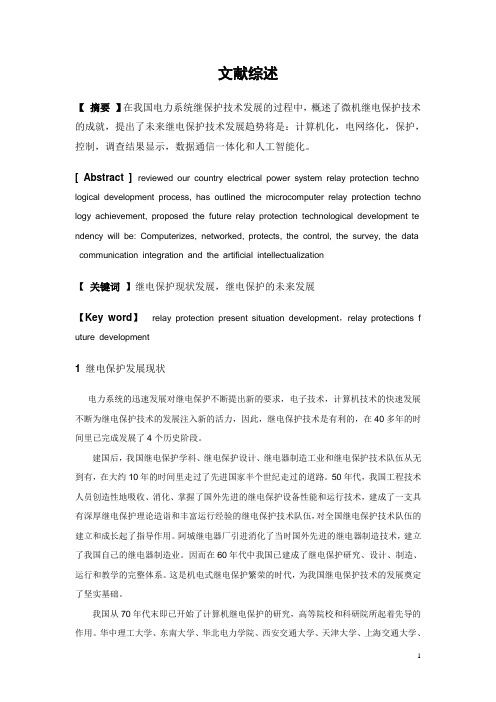
文献综述【摘要】在我国电力系统继保护技术发展的过程中,概述了微机继电保护技术的成就,提出了未来继电保护技术发展趋势将是:计算机化,电网络化,保护,控制,调查结果显示,数据通信一体化和人工智能化。
[ Abstract ]reviewed our country electrical power system relay protection techno logical development process, has outlined the microcomputer relay protection techno logy achievement, proposed the future relay protection technological development te ndency will be: Computerizes, networked, protects, the control, the survey, the data communication integration and the artificial intellectualization【关键词】继电保护现状发展,继电保护的未来发展【Key word】relay protection present situation development,relay protections f uture development1 继电保护发展现状电力系统的迅速发展对继电保护不断提出新的要求,电子技术,计算机技术的快速发展不断为继电保护技术的发展注入新的活力,因此,继电保护技术是有利的,在40多年的时间里已完成发展了4个历史阶段。
建国后,我国继电保护学科、继电保护设计、继电器制造工业和继电保护技术队伍从无到有,在大约10年的时间里走过了先进国家半个世纪走过的道路。
50年代,我国工程技术人员创造性地吸收、消化、掌握了国外先进的继电保护设备性能和运行技术,建成了一支具有深厚继电保护理论造诣和丰富运行经验的继电保护技术队伍,对全国继电保护技术队伍的建立和成长起了指导作用。
外文翻译与文献综述模板格式以及要求说明
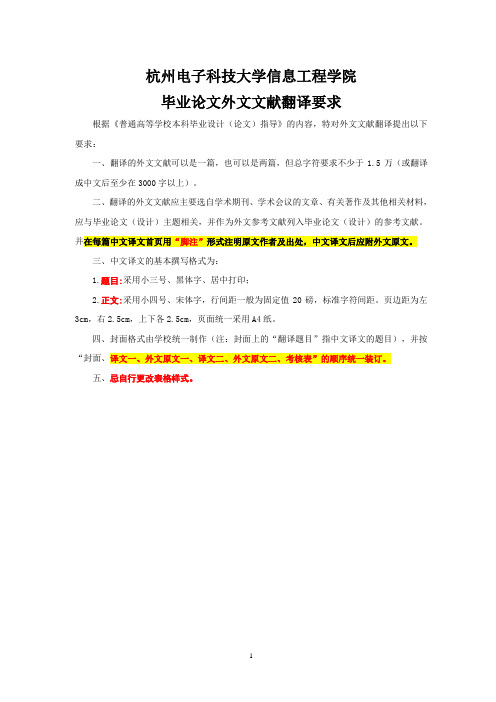
杭州电子科技大学信息工程学院毕业论文外文文献翻译要求根据《普通高等学校本科毕业设计(论文)指导》的内容,特对外文文献翻译提出以下要求:一、翻译的外文文献可以是一篇,也可以是两篇,但总字符要求不少于1.5万(或翻译成中文后至少在3000字以上)。
二、翻译的外文文献应主要选自学术期刊、学术会议的文章、有关著作及其他相关材料,应与毕业论文(设计)主题相关,并作为外文参考文献列入毕业论文(设计)的参考文献。
并在每篇中文译文首页用“脚注”形式注明原文作者及出处,中文译文后应附外文原文。
三、中文译文的基本撰写格式为:1.题目:采用小三号、黑体字、居中打印;2.正文:采用小四号、宋体字,行间距一般为固定值20磅,标准字符间距。
页边距为左3cm,右2.5cm,上下各2.5cm,页面统一采用A4纸。
四、封面格式由学校统一制作(注:封面上的“翻译题目”指中文译文的题目),并按“封面、译文一、外文原文一、译文二、外文原文二、考核表”的顺序统一装订。
五、忌自行更改表格样式。
毕业论文外文文献翻译毕业设计(论文)题目Xxx翻译(1)题目指翻译后的中文译文的题目翻译(2)题目指翻译后的中文译文的题目系会计系以本模板为准)专业XXXXXX(以本模板为准)姓名XXXXXX(以本模板为准)班级XXXXXX(以本模板为准)学号XXXXXX(以本模板为准)指导教师XXXXXX(以本模板为准)正文指导教师对外文翻译的评语:指导教师(签名)年月日建议成绩(百分制)评阅小组或评阅人对外文翻译的评语:评阅小组负责人或评阅人(签名)年月日建议成绩(百分制)杭州电子科技大学信息工程学院本科毕业论文文献综述的写作要求为了促使学生熟悉更多的专业文献资料,进一步强化学生搜集文献资料的能力,提高对文献资料的归纳、分析、综合运用能力及独立开展科研活动的能力,现对本科学生的毕业设计(论文)提出文献综述的写作要求,具体要求如下:一、文献综述的概念文献综述是针对某一研究领域或专题搜集大量文献资料的基础上,就国内外在该领域或专题的主要研究成果、最新进展、研究动态、前沿问题等进行综合分析而写成的、能比较全面地反映相关领域或专题历史背景、前人工作、争论焦点、研究现状和发展前景等内容的综述性文章。
英语笔译文献综述
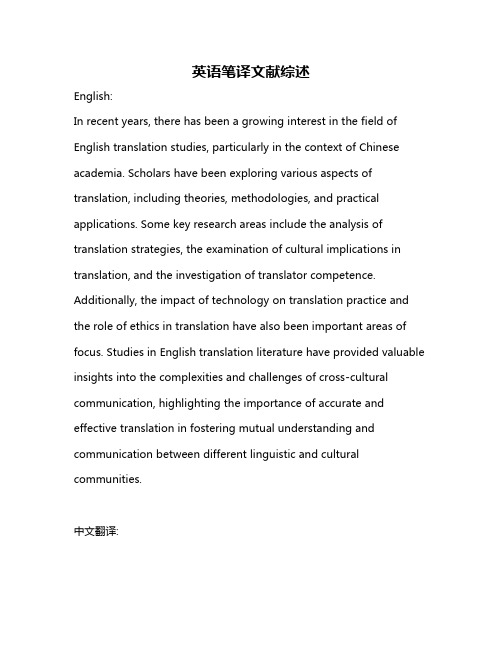
英语笔译文献综述English:In recent years, there has been a growing interest in the field of English translation studies, particularly in the context of Chinese academia. Scholars have been exploring various aspects of translation, including theories, methodologies, and practical applications. Some key research areas include the analysis of translation strategies, the examination of cultural implications in translation, and the investigation of translator competence. Additionally, the impact of technology on translation practice and the role of ethics in translation have also been important areas of focus. Studies in English translation literature have provided valuable insights into the complexities and challenges of cross-cultural communication, highlighting the importance of accurate and effective translation in fostering mutual understanding and communication between different linguistic and cultural communities.中文翻译:近年来,在英语翻译研究领域,特别是在中国学术界,越来越受到关注。
Internet中英文资料对照外文翻译文献综述
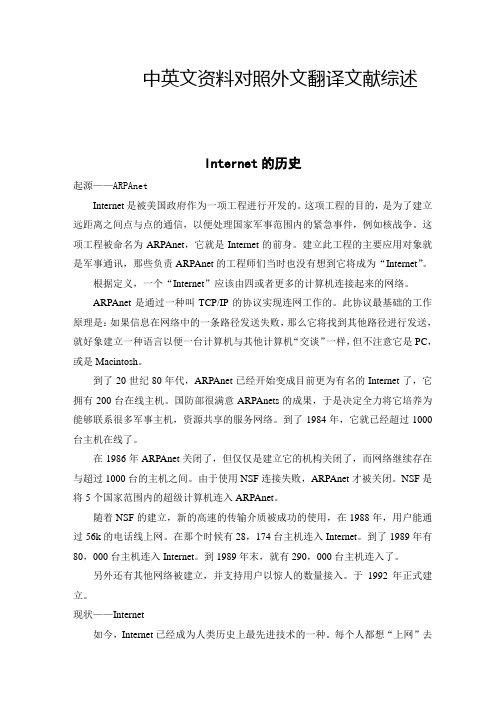
中英文资料对照外文翻译文献综述Internet的历史起源——ARPAnetInternet是被美国政府作为一项工程进行开发的。
这项工程的目的,是为了建立远距离之间点与点的通信,以便处理国家军事范围内的紧急事件,例如核战争。
这项工程被命名为ARPAnet,它就是Internet的前身。
建立此工程的主要应用对象就是军事通讯,那些负责ARPAnet的工程师们当时也没有想到它将成为“Internet”。
根据定义,一个“Internet”应该由四或者更多的计算机连接起来的网络。
ARPAnet是通过一种叫TCP/IP的协议实现连网工作的。
此协议最基础的工作原理是:如果信息在网络中的一条路径发送失败,那么它将找到其他路径进行发送,就好象建立一种语言以便一台计算机与其他计算机“交谈”一样,但不注意它是PC,或是Macintosh。
到了20世纪80年代,ARPAnet已经开始变成目前更为有名的Internet了,它拥有200台在线主机。
国防部很满意ARPAnets的成果,于是决定全力将它培养为能够联系很多军事主机,资源共享的服务网络。
到了1984年,它就已经超过1000台主机在线了。
在1986年ARPAnet关闭了,但仅仅是建立它的机构关闭了,而网络继续存在与超过1000台的主机之间。
由于使用NSF连接失败,ARPAnet才被关闭。
NSF是将5个国家范围内的超级计算机连入ARPAnet。
随着NSF的建立,新的高速的传输介质被成功的使用,在1988年,用户能通过56k的电话线上网。
在那个时候有28,174台主机连入Internet。
到了1989年有80,000台主机连入Internet。
到1989年末,就有290,000台主机连入了。
另外还有其他网络被建立,并支持用户以惊人的数量接入。
于1992年正式建立。
现状——Internet如今,Internet已经成为人类历史上最先进技术的一种。
每个人都想“上网”去体验一下Internet中的信息财富。
外文翻译及文献综述规范与要求
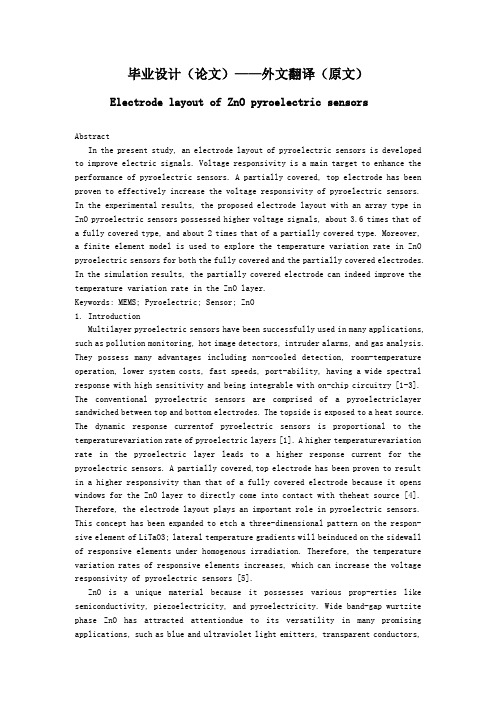
毕业设计(论文)——外文翻译(原文)Electrode layout of ZnO pyroelectric sensorsAbstractIn the present study, an electrode layout of pyroelectric sensors is developed to improve electric signals. Voltage responsivity is a main target to enhance the performance of pyroelectric sensors. A partially covered, top electrode has been proven to effectively increase the voltage responsivity of pyroelectric sensors. In the experimental results, the proposed electrode layout with an array type in ZnO pyroelectric sensors possessed higher voltage signals, about 3.6 times that of a fully covered type, and about 2 times that of a partially covered type. Moreover, a finite element model is used to explore the temperature variation rate in ZnO pyroelectric sensors for both the fully covered and the partially covered electrodes. In the simulation results, the partially covered electrode can indeed improve the temperature variation rate in the ZnO layer.Keywords: MEMS; Pyroelectric; Sensor; ZnO1. IntroductionMultilayer pyroelectric sensors have been successfully used in many applications, such as pollution monitoring, hot image detectors, intruder alarms, and gas analysis. They possess many advantages including non-cooled detection, room-temperature operation, lower system costs, fast speeds, port-ability, having a wide spectral response with high sensitivity and being integrable with on-chip circuitry [1-3]. The conventional pyroelectric sensors are comprised of a pyroelectriclayer sandwiched between top and bottom electrodes. The topside is exposed to a heat source. The dynamic response currentof pyroelectric sensors is proportional to the temperaturevariation rate of pyroelectric layers [1]. A higher temperaturevariation rate in the pyroelectric layer leads to a higher response current for the pyroelectric sensors. A partially covered,top electrode has been proven to result in a higher responsivity than that of a fully covered electrode because it opens windows for the ZnO layer to directly come into contact with theheat source [4]. Therefore, the electrode layout plays an important role in pyroelectric sensors. This concept has been expanded to etch a three-dimensional pattern on the respon- sive element of LiTaO3; lateral temperature gradients will beinduced on the sidewall of responsive elements under homogenous irradiation. Therefore, the temperature variation rates of responsive elements increases, which can increase the voltage responsivity of pyroelectric sensors [5].ZnO is a unique material because it possesses various prop-erties like semiconductivity, piezoelectricity, and pyroelectricity. Wide band-gap wurtzite phase ZnO has attracted attentiondue to its versatility in many promising applications, such as blue and ultraviolet light emitters, transparent conductors,solar cell windows, gas sensors, photovoltaic devices, pyroelectric imaging sensors, surface acoustic wave (SAW) devices and film bulk acoustic resonators (FBAR). ZnO films have been synthesized by numerous methods, such as metal organic chemical vapor deposition, molecular beam epitaxy, magnetron sputtering, pulsed laser deposition, atomic layer deposition, spray pyrolysis, the filtered cathodic vacuum arctechnique, and the sol-gel process. The quality of ZnO films obtained by these methods depends on the growth methods and conditions. Thus, preferential orientation of ZnO films depends on growth conditions. The most densely packed and thermodynamically favorable growth orientation in a ZnO wurtzite structure is the one with the c-axis perpendicular to a substrate. ZnO films, with the c-axis normal to the substrate, are preferred in many applications, such as ZnO pyroelectric devices [4, 6] and film bulk acoustic resonators [7]. The pyroelectricity of ZnO is attributable to non-centro-symmetrical crystals and has a specific polar axis along the direction of spontaneous polarization [1, 2]. Given that ZnO is subjected to temperature variations, its internal polarization will produce an electric field. ZnO films are usually deposited by RF sputtering. The properties of ZnO are affected by sputtering conditions such as the composition of mixed process gases, working注意:英文翻译标题格式: Times New Roman-四号-加粗;英文正文: Times New Roman-五号-单倍行距。
翻译报告英文文献综述

翻译报告英文文献综述Introduction:In recent years, there has been a growing interest in the study of [topic]. Several research articles have been published, investigating various aspects of this field. This literature review aims to provide a comprehensive overview of the current research in [topic], highlighting the key findings and methodologies employed.Methodology:To conduct this literature review, an extensive search was carried out across various academic databases, including PubMed, Google Scholar, and Web of Science. The search strategy involved using a combination of relevant keywords and search terms, such as [keywords]. The inclusion criteria for selecting articles included relevance to the topic, publication in peer-reviewed journals, and availability of full-text articles in English.Literature Review:1. Study 1: [Title]The first study by [Author] explored [specific aspect of topic]. The researchers conducted [brief description of research methodology], and their findings revealed [summary of key findings]. This study highlights the importance of [topic] in [relevant field] and suggests that [implications of findings].2. Study 2: [Title]In the second study by [Author], the focus was on [specific aspect of topic]. The researchers adopted [brief description of research methodology], and their results indicated [summary of key findings]. This study contributes to the understanding of [topic] by providing insights into [implications of findings].3. Study 3: [Title]Another study conducted by [Author] examined [specific aspect of topic]. The research design involved [brief description of research methodology]. The findings demonstrated [summary of key findings]. This study adds to the existing literature by [implications of findings].4. Study 4: [Title][Author] conducted a study investigating [specific aspect of topic]. The researchers employed [brief description of research methodology], and the results indicated [summary of key findings]. This study offers valuable insights into [implications of findings] and suggests further avenues for research in [topic].Discussion:The reviewed studies collectively contribute to the understanding of [topic]. They provide evidence regarding [aspects of topic], highlighting [implications of findings]. However, it is important to note that there are still gaps in the current knowledge, suggesting the need for further research in [topic].Conclusion:In conclusion, this literature review provides an overview of the recent research conducted in the field of [topic]. The reviewed studies contribute to the existing literature by offering valuable insights into [aspects of topic]. Based on the findings, it is evident that [implications of findings]. Future research should focus on addressing the existing gaps and expanding the knowledge base in [topic].References:1. [List of references cited in the literature review]。
外文翻译及文献综述规范与要求

毕业设计(论文)——外文翻译(原文)English Translation Title (外文原文标题)English Translation is a good work. English Translation is a good work. English Translation is a good work. English Translation is a good work. English Translation is a good work. English Translation is a good work. ……………………………………………………………………………………………………………………………………………………………………………………………………………………………………………………………………………………………………………注意:英文翻译标题格式: Times New Roman-四号-加粗;英文正文: Times New Roman-五号-单倍行距。
From:毕业设计(论文)——外文翻译(译文)外文译文标题英文翻译是个好工作。
英文翻译是个好工作。
英文翻译是个好工作。
英文翻译是个好工作。
英文翻译是个好工作。
英文翻译是个好工作。
英文翻译是个好工作。
英文翻译是个好工作。
英文翻译是个好工作。
英文翻译是个好工作。
英文翻译是个好工作。
英文翻译是个好工作。
英文翻译是个好工作。
…………………………………………………………………………………………………………………………………………………………注意:中文译文标题格式:宋体-三号-加粗;正文格式:宋体-五号-行距:1.25倍行距。
(1)翻译的资料必须与毕业设计有关(2)翻译后至少有2000汉字(3)文字简练、准确(特别注意术语)、流畅出处:关于××××××研究——文献综述湖州师范学院信息与工程学院(信息与工程系)060833 张三摘要:本文归纳了…和…研究中的关键问题,分析了…及其…的研究现状和发展趋势。
英语文献综述的范文
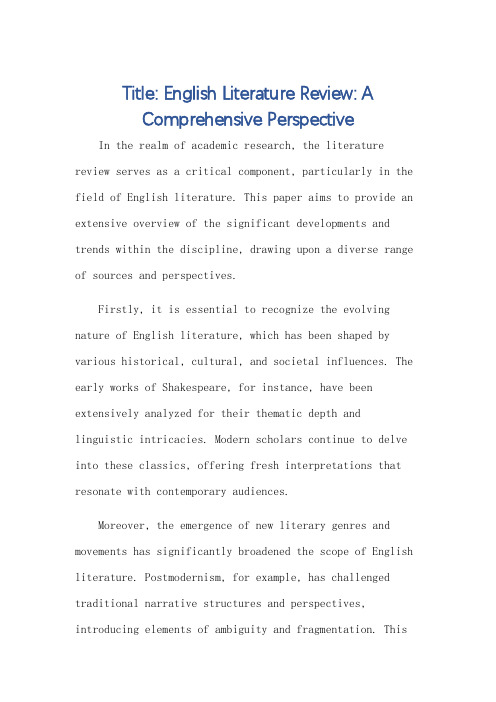
Title: English Literature Review: AComprehensive PerspectiveIn the realm of academic research, the literature review serves as a critical component, particularly in the field of English literature. This paper aims to provide an extensive overview of the significant developments and trends within the discipline, drawing upon a diverse range of sources and perspectives.Firstly, it is essential to recognize the evolving nature of English literature, which has been shaped by various historical, cultural, and societal influences. The early works of Shakespeare, for instance, have been extensively analyzed for their thematic depth andlinguistic intricacies. Modern scholars continue to delve into these classics, offering fresh interpretations that resonate with contemporary audiences.Moreover, the emergence of new literary genres and movements has significantly broadened the scope of English literature. Postmodernism, for example, has challenged traditional narrative structures and perspectives, introducing elements of ambiguity and fragmentation. Thistrend has been explored in numerous studies, highlighting the diverse ways in which authors have responded to and shaped the postmodern era.Furthermore, the intersection of English literature with other disciplines, such as psychology, sociology, and anthropology, has opened up new avenues for research. The exploration of character psychology in literary texts, or the analysis of societal norms and values reflected in literature, are just a few examples of thisinterdisciplinary approach.In terms of methodologies, the literature review has also undergone significant transformations. With the advent of digital technologies and online databases, scholars now have access to vast repositories of information, enabling them to conduct more comprehensive and rigorous reviews. However, the challenge lies in effectively synthesizing and evaluating this vast amount of data.One notable trend in recent years has been the increasing focus on global perspectives in English literature. With the growth of international literary movements and the rise of multiculturalism, scholars arenow more inclined to explore the global dimensions of literary works. This approach not only broadens our understanding of English literature but also promotes cross-cultural understanding and exchange.Moreover, the impact of gender and race on English literature has also been a topic of increasing interest. The examination of how gender roles and racial identities are represented and constructed in literary texts has provided valuable insights into the complex intersections of identity, power, and representation.In conclusion, the literature review in English literature is a dynamic and evolving field that continues to shape our understanding of the discipline. By exploring diverse themes, genres, and methodologies, scholars are able to delve deeper into the rich tapestry of English literature, revealing new meanings and perspectives that resonate with our contemporary world.**英语文献综述:全面视角**在学术研究领域,文献综述是一个至关重要的组成部分,尤其在英语文学领域更是如此。
文献综述和外文翻译
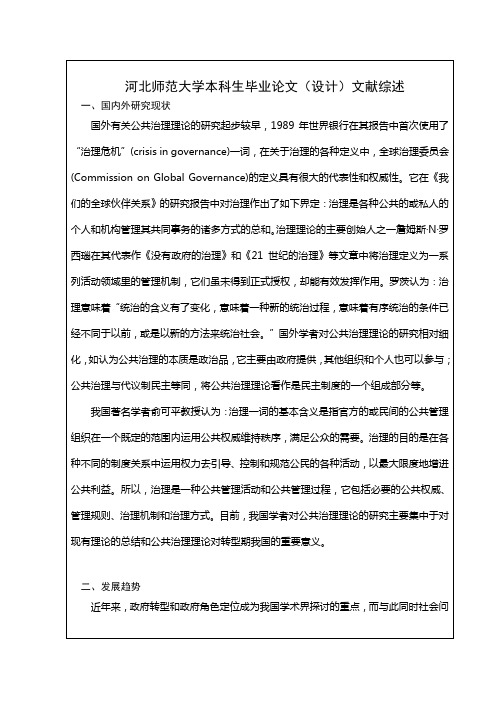
二、发展趋势
近年来,政府转型和政府角色定位成为我国学术界探讨的重点,而与此同时社会问题的频发也为政府执政提出更为严峻的考验。由西方发端的公共治理理论在政府与社会关系的讨论方面为政府职能改革提供了新的参考,现在及今后一段时期内将对政府角色定位产生深刻影响。
三、存在问题
公共治理理论在我国发展时间不久,虽然很多学者对其进行了研究与论述,但是普遍的社会认知尚未达到。我国目前正处于社会转型的关键时期,贫富差距拉大趋势明显,人民内部矛盾凸显,虽然我国政府一直在寻求很好的解决这些问题,但是收效甚微。公共治理理论可以为转型期我国政府角色定位提供理论参考,但是具体结合仍是问题根结所在,本文力图找到两者的结合点并提出建议。
Another strain on the traditional conception of governing arises from changes in the relationship between government and the private sector. At the extreme it is argued that "governance without government" is becoming the dominant pattern of management for advanced industrial democracies (Rhodes 1997).Other characterizations include "hollow" states and governments(Peters 1993; Rhodes 1994) and "negotiated" states and economies (Nielsen and Pedersen 1990). In all these depictions of changing patterns of government, it is argued that societal actor have become influential over policy and administration and have done so in waysthat were unimaginable in earlier times. Government is seen as weakened and as incapable of "steering" as it had in the past. The traditional concept of government as a controlling and regulating organization for society is argued to be outmoded (Bekke, Kickert, and Kooiman 1995).
文献综述和外文翻译的撰写要求

Keeping organizational information in a file-processing system has a number of major disadvantages.
?Data redundancy and inconsistency. Since the files and application programs are created by different programmers over a long period, the various files are likely to have different formats and the programs may be written in several programming languages. Moreover, the same information may be duplicated in several places (files). For example, the address and telephone number of a particular customer may appear in file that consists of savings-account records and in a file that consists of checking-account records. This redundancy leads to higher storage and access cost. In addition, it may lead to data inconsistency; that is, the various copies of the same data may no longer agree. For example, a changed coustomer address may be reflected in savings-account records but not elsewhere in the system.
英文文献综述的范文
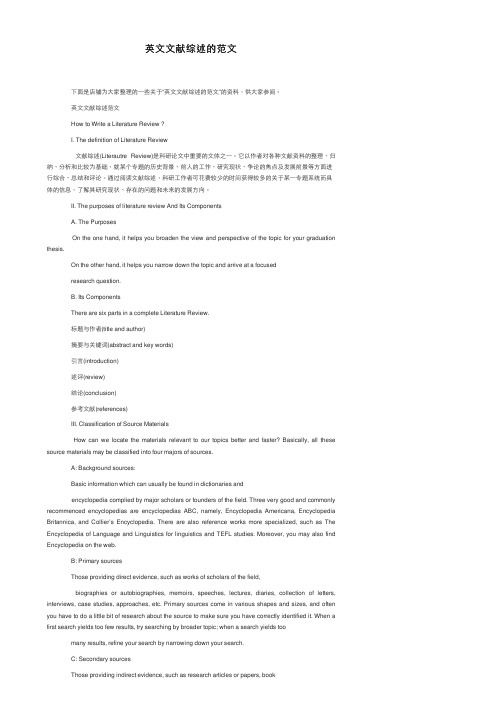
英⽂⽂献综述的范⽂ 下⾯是店铺为⼤家整理的⼀些关于“英⽂⽂献综述的范⽂”的资料,供⼤家参阅。
英⽂⽂献综述范⽂ How to Write a Literature Review ? I. The definition of Literature Review ⽂献综述(Literautre Review)是科研论⽂中重要的⽂体之⼀。
它以作者对各种⽂献资料的整理、归纳、分析和⽐较为基础,就某个专题的历史背景、前⼈的⼯作、研究现状、争论的焦点及发展前景等⽅⾯进⾏综合、总结和评论。
通过阅读⽂献综述,科研⼯作者可花费较少的时间获得较多的关于某⼀专题系统⽽具体的信息,了解其研究现状、存在的问题和未来的发展⽅向。
II. The purposes of literature review And Its Components A. The Purposes On the one hand, it helps you broaden the view and perspective of the topic for your graduation thesis. On the other hand, it helps you narrow down the topic and arrive at a focused research question. B. Its Components There are six parts in a complete Literature Review. 标题与作者(title and author) 摘要与关键词(abstract and key words) 引⾔(introduction) 述评(review) 结论(conclusion) 参考⽂献(references) III. Classification of Source Materials How can we locate the materials relevant to our topics better and faster? Basically, all these source materials may be classified into four majors of sources. A: Background sources: Basic information which can usually be found in dictionaries and encyclopedia complied by major scholars or founders of the field. Three very good and commonly recommenced encyclopedias are encyclopedias ABC, namely, Encyclopedia Americana, Encyclopedia Britannica, and Collier’s Encyclopedia. There are also reference works more specialized, such as The Encyclopedia of Language and Linguistics for linguistics and TEFL studies. Moreover, you may also find Encyclopedia on the web. B: Primary sources Those providing direct evidence, such as works of scholars of the field, biographies or autobiographies, memoirs, speeches, lectures, diaries, collection of letters, interviews, case studies, approaches, etc. Primary sources come in various shapes and sizes, and often you have to do a little bit of research about the source to make sure you have correctly identified it. When a first search yields too few results, try searching by broader topic; when a search yields too many results, refine your search by narrowing down your search. C: Secondary sources Those providing indirect evidence, such as research articles or papers, book reviews, assays, journal articles by experts in a given field, studies on authors or writers and their works, etc. Secondary sources will inform most of your writing in college. You will often be asked to research your topic using primary sources, but secondary sources will tell you which primary sources you should use and will help you interpret those primary sources. To use theme well, however, you need to think critically them. There are two parts of a source that you need to analyze: the text itself and the argument within the text. D: Web sources The sources or information from websites. Web serves as an excellent resource for your materials. However, you need to select and evaluate Web sources with special care for very often Web sources lack quality control. You may start with search engines, such as Google, Yahoo, Ask, Excite, etc. It’s a good idea to try more than one search engine, since each locates sources in its own way. When using websites for information, be sure to take care for the authorship and sponsorship. If they are both unclear, be critical when you use information. The currency of website information should also be taken into account. Don’t use too out information dated for your purpose. IV. Major strategies of Selecting Materials for literature review A. Choosing primary sources rather than secondary sources If you have two sources, one of them summarizing or explaining a work and the other the work itself, choose the work itself. Never attempt to write a paper on a topic without reading the original source. B. Choosing sources that give a variety of viewpoints on your thesis Remember that good argument essays take into account counter arguments. Do not reject a source because it makes an argument against you thesis. C. Choosing sources that cover the topic in depth Probably most books on Communicative Language Teaching mention William Littlewood, but if this your topic, you will find that few sources cover the topic in depth. Choose those. D. Choosing sources written by acknowledged experts If you have a choice between an article written by a freelance journalist on Task-based Teaching and one written by a recognized expert like David Nunan, Choose the article by the expert. E. Choosing the most current sources If your topic involves a current issue or social problem or development in a scientific field, it is essential to find the latest possible information. If all the books on these topics are rather old, you probably need to look for information in periodicals. V. Writing a literature Review A. When you review related literature, the major review focuses should be: 1. The prevailing and current theories which underlie the research problem. 2. The main controversies about the issue, and about the problem. 3. The major findings in the area, by whom and when. 4. The studies which can be considered the better ones, and why. 5. Description of the types of research studies which can provide the basis for the current theories and controversies. 6. Criticism of the work in the area. B. When you write literature review, the two principles to follow are: 1. Review the sources that are most relevant to your to your thesis. 2. Describe or write your review as clear and objective as you can. C. Some tips for writing the review: 1. Define key terms or concepts clearly and relevant to your topic. 2. Discuss the least-related references to your question first and the most related references last. 3. Conclude your review with a brief summary. 4. Start writing your review early. VI. ⽂献综述主要部分的细节性提⽰和注意事项 英⽂⽂献主要部分细节提⽰: 引⾔(Introduction) 引⾔是⽂献综述正⽂的开始部分,主要包括两个内容:⼀是提出问题;⼆是介绍综述的范围 和内容。
外文翻译文献综述
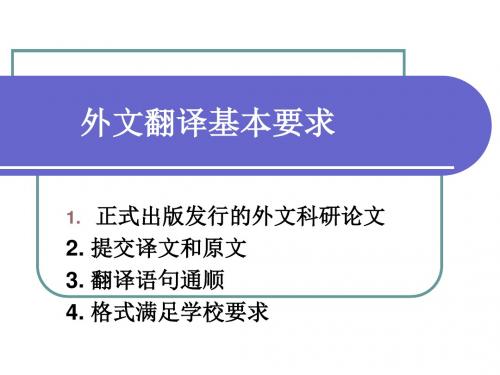
齿轮传动多轴头应用与设计
1.齿轮传动多轴头应用 2.齿轮传动多轴头的总体设计 齿轮传动多轴头加工机床的组成 机床的选择 联接部件和传动部件的结构 导向部件 多轴头加工的夹具
齿轮传动多轴头应用与设计
3.齿轮传动多轴头设计 齿轮传动多轴头组成 齿轮传动多轴头的设计步骤 齿轮传动多轴头的传动系统设计计算 4.机床夹具设计 机床夹具的作用 机床夹具的分类 专用夹具的组成 钻床夹具 钻床夹具的设计要点
文献综述的写作要求
文献综述的结论 文献研究的结论,概括指出自己对该课题的研 究意见,存在的不同意见和有待解决的问题等 文献综述的附录 列出参考文献,说明文献综述所依据的资料, 增加综述的可信度,便于读者进一步检索。 文献综述要文字简洁,围绕课题研究的“问 题”,尽量避免大量引用原文,要用自己的语 言把作者的观点说清楚,从原始文献中得出一 般性结论。
机械加工工艺与工装设计
1.工艺和工装设计介绍 2.生产过程与工艺过程: 3.工艺过程的组成: 4.机械加工工艺规程及其作用: 5.齿轮的材料、热处理和毛坯 6.齿轮轮齿的加工方法 7.圆柱齿轮加工工艺和常用工艺装备 8.光滑尺寸的检查及量具设计
箱体零件加工工艺
.1.结构特点及技术要求 2.毛坯和材料的选择 3.加工工艺的设计 1).加工顺序安排 2).定位基准的选择 3).主要表面的加工方法 4).孔系加工
文献综述的写作要求
文献综述的基本特征: 1. 综合性 (对某一时期同一课题的所有主要研究 成果的综合概括) 2. 描述性 (对被介绍的观点作客观性的描述) 3. 评价性 (表明自己的观点和主张。“述”与 “评’)
文献综述例文英文翻译
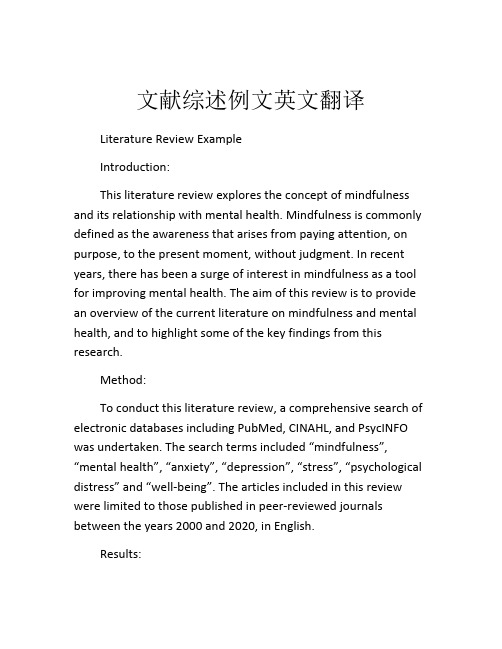
文献综述例文英文翻译Literature Review ExampleIntroduction:This literature review explores the concept of mindfulness and its relationship with mental health. Mindfulness is commonly defined as the awareness that arises from paying attention, on purpose, to the present moment, without judgment. In recent years, there has been a surge of interest in mindfulness as a tool for improving mental health. The aim of this review is to provide an overview of the current literature on mindfulness and mental health, and to highlight some of the key findings from this research.Method:To conduct this literature review, a comprehensive search of electronic databases including PubMed, CINAHL, and PsycINFO was undertaken. The search terms included “mindfulness”, “mental health”, “anxiety”, “depression”, “stress”, “psychological distress” and “well-being”. The articles included in this review were limited to those published in peer-reviewed journals between the years 2000 and 2020, in English.Results:The results of this literature review indicate that mindfulness-based interventions are effective in reducing symptoms of anxiety, depression, and psychological distress. Studies have found that mindfulness training can lead to significant improvements in individual well-being, reduced stress, and increased positive affect. One study found that mindfulness meditation was more effective than cognitive-behavioral therapy (CBT) in reducing symptoms of depression and anxiety in individuals with major depressive disorder. Other studies have found that mindfulness-based interventions can improve cognitive functioning, attention, and emotion regulation.Discussion:The findings of this literature review suggest that mindfulness-based interventions hold promise as effective tools for improving mental health. The results indicate that mindfulness training can provide individuals with the tools they need to manage symptoms of anxiety, depression, and psychological distress. Given the effectiveness of mindfulness-based interventions, it appears that these practices have the potential to become an important addition to conventional treatments for mental health disorders.Conclusion:In conclusion, this literature review highlights the importance of mindfulness-based interventions in improving mental health. The results of this review suggest that mindfulness training canlead to significant improvements in individual well-being, reduced stress, and increased positive affect. Further research is needed to elucidate the underlying mechanisms by which mindfulness-based interventions work. Nonetheless, the practical applications of mindfulness practices in treating anxiety, depression, and psychological distress suggest that these interventions have the potential to become an important component of mental health treatments.。
英语文献综述 范文
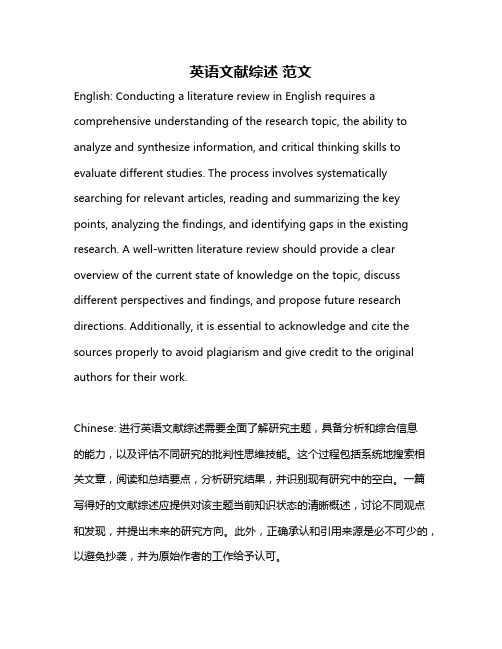
英语文献综述范文English: Conducting a literature review in English requires a comprehensive understanding of the research topic, the ability to analyze and synthesize information, and critical thinking skills to evaluate different studies. The process involves systematically searching for relevant articles, reading and summarizing the key points, analyzing the findings, and identifying gaps in the existing research. A well-written literature review should provide a clear overview of the current state of knowledge on the topic, discuss different perspectives and findings, and propose future research directions. Additionally, it is essential to acknowledge and cite the sources properly to avoid plagiarism and give credit to the original authors for their work.Chinese: 进行英语文献综述需要全面了解研究主题,具备分析和综合信息的能力,以及评估不同研究的批判性思维技能。
- 1、下载文档前请自行甄别文档内容的完整性,平台不提供额外的编辑、内容补充、找答案等附加服务。
- 2、"仅部分预览"的文档,不可在线预览部分如存在完整性等问题,可反馈申请退款(可完整预览的文档不适用该条件!)。
- 3、如文档侵犯您的权益,请联系客服反馈,我们会尽快为您处理(人工客服工作时间:9:00-18:30)。
箱体零件加工工艺
4.夹具设计 5.光滑尺寸的检查及量具设计 6.切削刀具材料选择及设计
液压系统设计文献综述
1.组合机床的液压传动 2.液压传动的组成与类型 3.液压系统的拟定 4.选择液压回路 5.液压系统图的拟定 6.液压元件的选型 7.液压控制阀组的集成化设计 8.液压站的设计
把走进工作岗位当作职业生涯的重要的第一步,认 真思考如何为以后的发展开好头。
Thank you
的制造方法、箱体的加工 组合机床设计内容 包括:组合机床设计、机床设计、机床夹具、组合机床工
艺流程 多轴加工设计内容 包括:齿轮、轴的设计、机床夹具、多轴加工、钻床改造
设计 组合机床液压传动设计内容 包括:液压传动、液压阀、泵、液压缸、液压站、液压技
术
文献综述的写作要求
文献综述的基本特征: 1. 综合性
如何找外文原文
手工查找图书馆期刊部收藏的外文期刊 检索图书馆外文数据库 利用网络检索 google 、google scholor ()等外文学术
收索引擎。
题目相关内容
工艺工装设计内容 包括:各种切削加工及工艺、齿轮加工、机床夹具、齿轮
组合机床设计
1.组合机床组成及特点 2.组合机床的工艺范围 3.确定组合机床工艺方案的基本原则 4.组合机床方案分析比较的主要指标 5.组合机床行业发展历史概况 6.组合机床技术发展与动向
组合机床设计
7.组合机床的设计思想 8.组合机床常用工艺方法 9确定组合机床工艺方案的原则 10.组合机床不同配置形式的特点及适应
被拒绝是招聘单位对我们综合考虑的结果,因为我 们最关心的是自己什么地方与用人要求不一致,而 不仅仅是面试中的表现。
不要欺骗自己,说“我本来就不想去”等等。 认真考虑是否有必要再做努力。
必须学会欣然面对的一种结果----被接纳
以具体的形式感谢招聘单位的接纳,如邮件、短信 考虑怎样使自己的知识能力更适应工作需要
(对某一时期同一课题的所有主要研究 成果的综合概括) 2. 描述性 (对被介绍的观点作客观性的描述) 3. 评价性 (表明自己的观点和主张。“述”与 “评’)
文献综述的写作要求
文献综述格式一般包括 文献综述的引言
包括撰写文献综述的原因、意义、文献的范围、 正文的标题及基本内容提要; 文献综述的正文 是文献综述的主要内容,包括某一课题研究的 历史 (寻求研究问题的发展历程)、现状、基本 内容 (寻求认识的进步), 研究方法的分析(寻求 研究方法的借鉴),已解决的问题和尚存的问题, 重点阐述对当前的影响及发展趋势
性 11.组合机床组成 12.组合机床工艺方案制定
齿轮传动多轴头应用与设计
1.齿轮传动多轴头应用 2.齿轮传动多轴头的总体设计 齿轮传动多轴头加工机床的组成 机床的选择 联接部件和传动部件的结构 导向部件 多轴头加工的夹具
齿轮传动多轴头应用与设计
3.齿轮传动多轴头设计 齿轮传动多轴头组成 齿轮传动多轴头的设计步骤 齿轮传动多轴头的传动系统设计计算 4.机床夹具设计 机床夹具的作用 机床夹具的分类 专用夹具的组成 钻床夹具 钻床夹具的设计要点
机械加工工艺与工装设计
1.工艺和工装设计介绍 2.生产过程与工艺过程: 3.工艺过程的组成: 4.机械加工工艺规程及其作用: 5.齿轮的材料、热处理和毛坯 6.齿轮轮齿的加工方法 7.圆柱齿轮加工工艺和常用工艺装备 8.光滑尺寸的检查及量具设计
箱体零件加工工艺
.1.结构特点及技术要求 2.毛坯和材料的选择 3.加工工艺的设计
文献综述的写作要求
文献综述的结论 文献研究的结论,概括指出自己对该课题的研
究意见,存在的不同意见和有待解决的问题等 文献综述的附录 列出参考文献,说明文献综述所依据的资料,
增加综述的可信度,便于读者进一步检索。 文献综述要文字简洁,围绕课题研究的“问
题”,尽量避免大量引用原文,要用自己的语 言把作者的观点说清楚,从原始文献中得出一 般性结论。
外文翻译基本要求
1. 正式出版发行的外文科研论文 2. 提交译文和原文 3. 翻译语句通顺 4. 格式满足学校要求
具体要求和注意点:
1、文献应以英、美等国家公开发表的文献为主 (Journals from English speaking countries)。
2、翻译是相对独立的,其中应该包括题目、作者(可 以不翻译)、译文的出处(杂志的名称、关键词、摘要、 前言、正文、总结等几个部分。
3、文献翻译的字体、字号、序号等应与毕业论文格式 要求完全一致。
4、文中所有的图表、致谢及原文)。
5、原文中出现的专用名词及人名、地名、参考文献可 不翻译,并同原文一样在正文中标明出处。
6. 上缴翻文及PDF的原文
求职应注意的礼仪
求职时最礼貌的修饰是淡妆 面试时最关键的神情是郑重
无论站还是坐,不能摇动和抖动 对话时目光不能游弋不定 要控制小动作 不要为掩饰紧张情绪而散淡
最优雅的礼仪修养是体现自然
以一种修养面对两种结果
必须首先学会面对的一种结果----被拒绝
仍然感谢这次机会,因为被拒绝是面试后的两种结 果之一。
